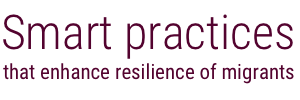Internal programmes to increase diversity of National Society staff and volunteers. In order to understand the full spectrum of needs, vulnerabilities and sensitivities of different migrants and ensure services are effective, service providers benefit from having a more diverse staff and volunteer workforce.
The Swedish Red Cross recognized the need to improve the diversity and cultural fluency of its staff and volunteers. Given the increasingly multi-cultural environment in the country, and particularly in response to the inflow of migrants, a diverse staff and volunteer base is critical to a better understanding of the subtleties of the issues facing the various migrant groups in Sweden. A group of staff and volunteers therefore hold regular lectures and workshops for local, regional and national branches to provide information to volunteer groups on how to improve diversity. Branches and volunteer groups receive guidance on how to attract new members who do not fit the existing member profile. In addition, the local, regional and national branch leaderships advocate for a more conscious effort to improve the racial, socio-economic and religious diversity of staff.
A Syrian who migrated to Sweden and subsequently joined the National Society in Sweden provides a compelling example of the benefits of including a wide range of perspectives amongst staff and volunteers. She joined a local branch and is generally considered to have had a very positive impact on the effectiveness and completeness of the programmes of that branch.
- Existing structures and norms amongst volunteers and staff are not always conducive to building diversity.
- It is important to strengthen the ability to engage occasional and spontaneous volunteers.
- Recruitment practices are not always geared to the groups that need to be reached.
- A clear and defined need to be addressed (e.g., assisting migrants) means that more people want to engage, which in turn leads to a more diverse pool of volunteers.
- Shorter assignments and introductions facilitate recruitment of people with different backgrounds.
- Strategic recruitment of certain competencies can promote more diverse recruitment.

